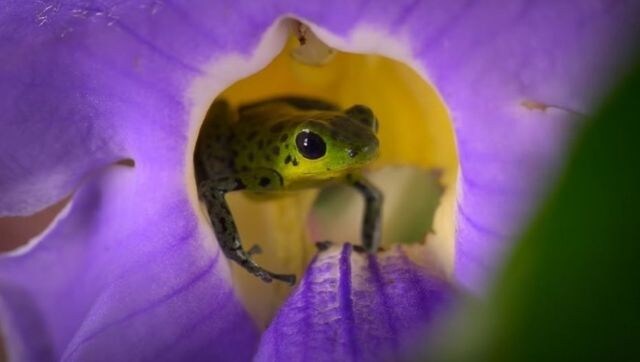World Earth Day: With new technology, Netflix docu-series Life in Colour makes wildlife research accessible
By viewing the daily activity of the wild through the lens of colour, the show brings forth the importance of such documentaries as a snapshot of the latest research, democratising education in a way that only the internet can.

A Netflix World Earth Day special, Life in Colour with David Attenborough, is a three-part docu-series that delves into the role colour plays in the natural world. Through the three episodes – ‘Seeing in Colour,’ ‘Hiding in Colour,’ and ‘Chasing Colour’ – it shows how animals use colour to identify threats and prey, flaunt it to attract mates and repel rivals, and more. Through ultraviolet cameras developed specifically for the show, one also sees how animals see colours, their view often including UV light which humans cannot see.
Rather predictably, the series kicks off with a peacock on display. While one is aware of the Indian national bird’s beauty, the show, with high production quality, reiterates to viewers just how rich the peacock’s blue and green are, how impressively the eyes along its feathers open up, and how important the role of colour is in their lives. Besides peacocks, the series also shows how the male Costa’s hummingbirds and Magnificent bird-of-paradise use their feathers to engage in elaborate courtship rituals, centred around their colours, to attract mates.
Flamingos, touted for their fleshy pink colour, originally grow up as white-feathered birds. The salty waters in which they feed often house algae and shrimps, both of which contain red pigments called carotenoids, which over time give their feathers the rich pink colour. Instead of just passively being coloured though, flamingos use the colour to distinguish between desirable mates. For instance, a mother who has recently given birth is going to be completely white, since all her surplus food and energy has gone into producing an egg and then feeding her chick. She must now wait out this mating season, since the pink is an indication of body reserves, making it a marker of their health and strength. Here, instead of being a tool of attraction, colour works as a type of basic checklist when considering from multiple possible mates.
Besides showing how several animals use colour in their life, the show also takes a brief look at history and evolution, jumping back 700 million years, when the first animals did not have the ability to distinguish between colours. “Birds, close relatives of dinosaurs, appeared before mammals,” says Attenborough in the show, adding that their colour vision is stronger than mammals. The first mammals also were not very colourful, something that is still largely true today. From giraffes to tigers and elephants, mammals are mostly along the tones of black, white, and brown.
“The first mammals, as far as we can tell, were mostly nocturnal. Colours are not easily distinguishable at night, so why evolve the ability to detect them?” While this question remains largely unanswered, the show does point to a rare exception, the mandrill, a point of focus from the perspective of evolution. As male mandrills become sexually mature, colour appears on their faces and rumps, and is used as a display of strength and ferocity. They are also trichromatic, like members of the Old World monkey family, compared to New World monkeys where it is most often only females who are trichromatic while males are dichromatic.
Another example of colour leading to a greater understanding of why a species has evolved a certain way are zebras, living around predators like lions, hyenas, and cheetahs, with their bold, contrasting black and white stripes. “How do they get away with it? The question has been hotly debated by naturalists for centuries,” says Attenborough. Much like the confusion over whether the viral “dress” was blue and black or white and gold led to new research, the question of how zebras survive also offers new insight when one considers colour, vision, and optical illusions. New research suggests that while black and white are strong contrasts, when zebras move, the stripes create confusion. “It’s known as motion dazzle. And it makes it difficult for a predator to keep focused on one particular target.” And a few seconds’ worth of confusion is enough to allow a zebra to get away, possibly suggesting itself as the reason for not physically evolving in terms of colour.
The third episode of the show focuses on how the crew captured the mesmerising stills, and explains the special camera system that made it possible to see the world the way an animal does. Two cameras are sat next to each other, one seeing in colour as humans would, and the other seeing in ultraviolet like an insect. An ultraviolet filter – which allows UV light to pass through it and reflects white/normal light – is placed diagonally between the two cameras, sending the correct light in each camera’s lens.
When applied to a yellow flower, the UV camera detects shades of another colour in the middle of each petal, offering new data about the insects and birds it must attract. Also, several birds, lizards, insects, and fish can see UV light, and are often reacting to things we cannot see, hinting at just how much there is still to discover.
“Scientists are only just beginning to reveal how animals use these ultraviolet colours,” adds Attenborough in the episode. The research of Dr Darrell Kemp of Macquarie University at Coffs Harbour, New South Wales, focuses on mating displays in butterflies. He has caught a hypolimnas bolina, also known as the blue moon butterfly. Through the UV light, one can see that the little white patches on its wings are like mirrors reflecting the intensity of the UV light coming from the sun. Kemp also starts to see things that better explain butterfly behaviour. Females will judge potential mates by looking at the male wings’ display – the brighter the UV markings, the more attractive the male.
From tiny insects like bees to amphibians like frogs and from birds to large mammals like tigers, viewing the daily activity of the wild through the lens of colour, and aided by the new technology, Life in Colour with David Attenborough also brings forth the importance of such documentaries as a snapshot of the latest research, made easily accessible to all with a Netflix subscription, democratising education in a way that only the internet can.
Life in Colour with David Attenborough is streaming on Netflix.
also read

Earth day 2021: What can Joe Biden’s summit achieve for climate action?
One of the outcomes of this summit could be US and China working together to achieve their targets during the next few years.

Earth day 2021: Climate scientists caution concept of net zero is a dangerous trap
If we deploy CO2 removal techniques and reduce fossil fuel burning, it is believed that we can halt global warming.

Earth day 2021: Microbial diversity is under threat which endangers the rest of the planet
temperature shifts associated with climate change affect the composition of microorganisms in the environment.





